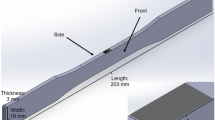Abstract
The surface topography and mechanical properties of coatings prepared using large particle size polyurethane dispersions (PUD) are investigated using atomic force microscopy (AFM) imaging, AFM-based force measurements, and friction force microscopy. PUD coatings, which are prepared from dispersions containing particles of micron size, have surface roughness of 250–300 nm and waviness of 2.5–3 μm resulting from the particle size. The surface moduli of the PUD coatings are varied by tuning the ratio of hard-to-soft segmentation in the polyurethanes and are found to be between 40 and 100 MPa. The friction coefficient obtained in the study is found to be correlated with both the surface modulus of the coatings and the adhesion between the probe and the samples and is well in line with the perceived feel of an experienced human panel. The data are very well behaved and clearly show the utility of this technique in characterizing these types of surfaces.





Similar content being viewed by others
References
Skedung, L, Arvidsson, M, Chung, JY, Stafford, CM, Berglund, B, Rutland, M, “Feeling Small: Exploring the Tactile Perception Limits.” Sci. Rep., 3 2617 (2013)
Tomlinson, SE, Lewis, R, Carre, MJ, “The Effect of Normal Force and Roughness on Friction in Human Finger Contact.” Wear, 267 1311 (2009)
Derler, S, Gerhardt, LC, Lenz, A, Bertaux, E, Hadad, M, “Friction of Human Skin Against Smooth and Rough Glass as a Function of the Contact Pressure.” Tribol. Int., 42 1565 (2009)
Derler, S, Gerhardt, LC, “Tribology of Skin: Review and Analysis of Experimental Results for the Friction Coefficient of Human Skin.” Tribol. Lett., 45 1 (2011)
Wang, Y, Juhué, D, Winnik, MA, Leung, OM, Goh, MC, “Atomic Force Microscopy Study of Latex Film Formation.” Langmuir, 8 760 (1992)
Miyake, K, Satomi, N, Sasaki, S, “Elastic Modulus of Polystyrene Film from Near Surface to Bulk Measured by Nanoindentation Using Atomic Force Microscopy.” Appl. Phys. Lett., 89 031925 (2006)
Passeri, D, Bettucci, A, Biagioni, A, Rossi, M, Alippi, A, Lucci, M, Davoli, I, Berezina, S, “Quantitative Measurement of Indentation Hardness and Modulus of Compliant Materials by Atomic Force Microscopy.” Rev. Sci. Instrum., 79 066105 (2008)
Palacio, MLB, Bhushan, B, “Depth-Sensing Indentation of Nanomaterials and Nanostructures.” Mater. Charact., 78 1 (2013)
Lohmeijer, B, Balk, R, Baumstark, R, “Preferred Partitioning: The Influence of Coalescents on the Build-Up of Mechanical Properties in Acrylic Core–Shell Particles (I).” J. Coat. Technol. Res., 9 399 (2012)
Takahara, A, Kobayashi, M, Terayama, Y, Hosaka, N, Kaido, M, Suzuki, A, Yamada, N, Torikai, N, Ishihara, K, “Friction Behavior of High-Density Poly(2-methacryloyloxyethyl phosphorylcholine) Brush in Aqueous Media.” Soft Matter, 3 740 (2007)
Vyas, MK, Schneider, K, Nandan, B, Stamm, M, “Switching of Friction by Binary Polymer Brushes.” Soft Matter, 2008 4 (1024)
Schönherr, H, Tocha, E, Vancso, GJ, “Friction and Surface Dynamics of Polymers on the Nanoscale by AFM.” Top. Curr. Chem., 285 103 (2008)
Dieterich, D, “Aqueous Emulsions, Dispersions and Solutions of Polyurethanes; Synthesis and Properties.” Prog. Org. Coat., 9 281 (1981)
Xiao, HX, Yang, S, McLean, JA, Frisch, KC, Water-Borne & Higher Solids and Powder Coatings Symp., 24–26 Feb 1993, New Orleans, LA, USA
Stone, H, Sidel, J, Oliver, S, Woolsey, A, Singleton, RC, “Sensory Evaluation by Quantitative Descriptive Analysis.” Food Technol., 28 24 (1974)
Chen, Q, Kooij, ES, Sui, X, Padberg, CJ, Hempenius, MA, Schön, PM, Vancso, GJ, “Collapse from the Top: Brushes of Poly(N-isopropylacrylamide) in Co-nonsolvent Mixtures.” Soft Matter, 10 3134 (2014)
Sui, X, Chen, Q, Hempenius, MA, Vancso, GJ, “Probing the Collapse Dynamics of Poly(N‐isopropylacrylamide) Brushes by AFM: Effects of Co‐nonsolvency and Grafting Densities.” Small, 7 1440 (2011)
Butt, H-J, Cappella, B, Kappl, M, “Force Measurements with the Atomic Force Microscope: Technique, Interpretation and Applications.” Surf. Sci. Rep., 59 1 (2005)
Liu, XT, Thormann, E, Dedinaite, A, Rutland, M, Visnevskij, C, Makuskac, R, Claesson, PM, “Low Friction and High Load Bearing Capacity Layers Formed by Cationic-Block-Non-ionic Bottle-Brush Copolymers in Aqueous Media.” Soft Matter, 9 5361 (2013)
Johnson, KL, Contact Mechanics. Cambridge University Press, Cambridge, 1985
Acknowledgments
The authors would like to thank DSM for permission to publish this paper. Ad Overbeek and Fred Buckmann are acknowledged for their helps in the study and comments on the manuscript.
Author information
Authors and Affiliations
Corresponding authors
Rights and permissions
About this article
Cite this article
Chen, Q., Swaans, R., de Kok, P. et al. Surface topography and tribological properties of coatings prepared from microparticle size polyurethane dispersions studied by atomic force microscopy. J Coat Technol Res 15, 713–719 (2018). https://doi.org/10.1007/s11998-018-0067-2
Published:
Issue Date:
DOI: https://doi.org/10.1007/s11998-018-0067-2




